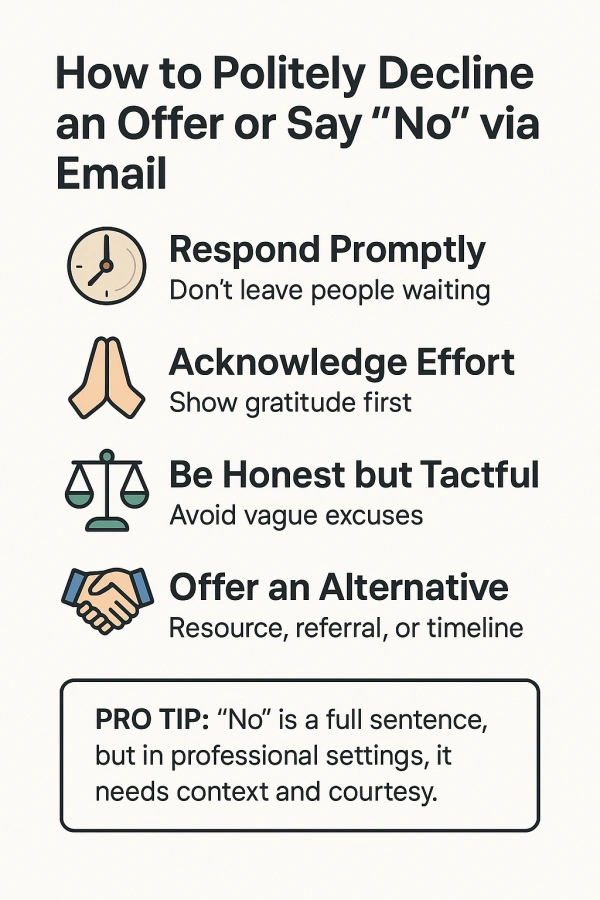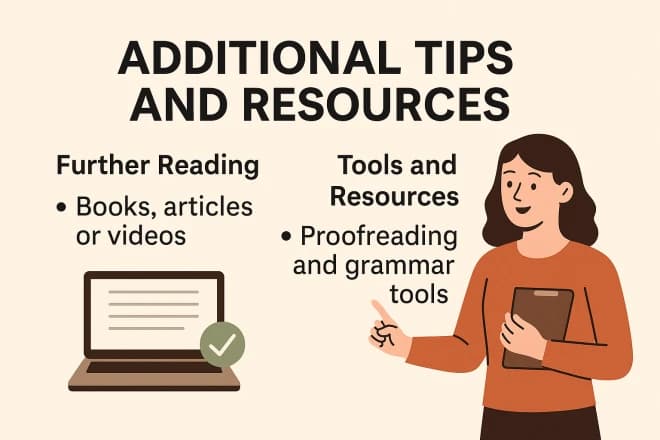Unlock Insights: Find the Answers You Seek on Our Blog
How to Polite decline an Offer or Say “No” via Email (Without Burning Bridges)
By Evelyn Sterling
Why Saying “No” Matters in Professional Communication
In professional life, refusing a request isn’t what damages relationships—unclear or delayed communication does. When we avoid giving a direct answer, we create uncertainty, false hope, and unnecessary emotional strain for both sides. A polite and timely “no” shows responsibility, honesty, and respect for the other person’s time.
Agreeing out of pressure may feel easier in the moment, but it can lead to workload overload, reduced performance, emotional fatigue, and long-term frustration. Setting boundaries is not selfish; it’s a way to protect your credibility and maintain healthy, sustainable working relationships. In the next section, we’ll look at practical language patterns that help you decline with clarity and kindness.

The Golden Rules of a Polite Professional Rejection
A polite rejection is less about finding “perfect” wording and more about being fair, clear, and considerate.
When you keep a few simple rules in mind, it becomes much easier to say “no” without feeling guilty or damaging the relationship.
- ⏱️ Respond promptly
Once you have a decision, let the other person know. Long silence creates uncertainty and can feel more hurtful than a clear, respectful “no.” - 🙏 Acknowledge effort
Start by thanking them for their time, offer, or interest. Even a one-line appreciation shows you don’t take their outreach for granted. - ⚖️ Be honest but tactful
Give a brief, truthful reason without over-sharing. Avoid invented excuses; they are hard to maintain and may sound insincere. - 🎯 Be clear
Make sure your “no” cannot be misread as “maybe later” unless you genuinely mean it. Clarity prevents false hope and repeated follow-ups. - 🤝 Optionally offer an alternative
When appropriate, you can suggest a different time, share a helpful resource, or refer someone else. This is a kind gesture, not an obligation.
💡 Pro tip: “No” is a complete answer, but in professional communication it works best when wrapped in context and courtesy.
In the next section, we’ll turn these principles into concrete phrases and sentence starters you can reuse in your own emails.
Helpful Language Patterns & Polite Sentence Starters
When declining, the tone matters as much as the message. Using gentle, professional wording helps convey respect while still communicating your boundary.
Below are practical sentence starters you can copy and adapt depending on your situation.
🌿 Soft Decliners (Warm + Appreciative)
Ideal for situations where you want to acknowledge the offer with kindness before transitioning into a refusal.
- “Thank you so much for thinking of me…”
- “I truly appreciate the opportunity…”
- “While it sounds like a great initiative…”
- “I’m grateful you reached out and included me…”
🛑 Boundary Setters (Clear + Professional)
Use these when you need to communicate limits without overexplaining or apologizing.
- “At the moment, I’m focusing on…”
- “I’m currently at full capacity…”
- “It wouldn’t be fair for me to commit…”
- “I’m prioritizing existing commitments right now…”
🤝 Closure Statements (Positive + Future-Friendly)
Useful for ending the message in a way that maintains goodwill and leaves the door open — only if you want to.
- “I hope we can collaborate another time.”
- “Please keep me in mind for future opportunities.”
- “Wishing you great success with the project.”
- “Let’s stay connected in case our timing aligns later.”
💬 Tip: You can mix one line from each category to create a balanced rejection:
Appreciation + Boundary + Closure.
3 Practical Email Templates (Copy & Customize)
Below are three professional templates that follow the structure:
appreciation → clear boundary → respectful closure.
Feel free to adjust tone, length, and detail based on your relationship with the recipient.
1️⃣ Declining a Job Offer
Subject: Thank You for the Opportunity Hi [Name], Thank you for offering me the [Position] role and for the time you and the team invested throughout the interview process. I enjoyed learning more about [Company/Team] and truly appreciate the warm communication. After careful consideration, I’ve decided to move forward with an opportunity that aligns more closely with my current focus and goals. This was not an easy decision, and I’m grateful for your understanding. I wish you and the team continued success, and I hope our paths may cross again in the future. Warm regards, [Your Name]
2️⃣ Declining a Sales Pitch, Collaboration, or Product Demo
Hi [Name], Thank you for reaching out and sharing more about [Product/Service/Proposal]. I can see the value it provides, and I appreciate the time you spent explaining it. At this time, I’m not planning to move forward or explore new tools/partnerships, so I’ll need to decline. I prefer to stay focused on my current workflow and commitments. Thank you again for thinking of me — wishing you a successful launch and strong results ahead. Best regards, [Your Name]
3️⃣ Saying No to a Meeting or Discussion Request
Hi [Name], Thank you for inviting me to connect on this topic. I appreciate your initiative and interest. I’m currently managing a full schedule and won’t be able to join the meeting. If it’s helpful, feel free to send over key points or questions by email, and I’ll review them when I can. Thanks for your understanding, and I hope the discussion goes smoothly. Regards, [Your Name]
📝 Suggestion: Re-read your message once before sending. Removing overly apologetic language (e.g., “I’m so sorry,” “I feel bad,” or “I hope you’re not disappointed”) often makes the communication sound more confident and respectful.
How to Maintain the Relationship After Saying No
A respectful rejection doesn’t need to be the end of the conversation. In many cases,
how you follow up matters more than the refusal itself. If you value the person, their
work, or the future potential of the relationship, consider taking small actions that
signal goodwill and continued interest — without violating your boundaries.
- 🔗 Stay connected on LinkedIn or other professional platforms
A simple follow, thoughtful comment, or message can show that you still value the relationship, even if you declined this time. - ⏳ Offer possible future timing (only if realistic)
If you genuinely see potential, propose a rough timeline or milestone (e.g., “Let’s revisit after Q2”). Avoid offering dates you’re unlikely to honor. - 👥 Provide a referral or alternative resource
If someone else in your network might be a better fit — and you’re confident it’s appropriate — a warm referral can leave a positive impression for everyone involved. - 🔁 Use “not now” instead of “never,” when true
Only choose this language if you sincerely want to keep the door open. Clear honesty prevents misunderstandings and ensures trust.
Ultimately, maintaining relationships after saying no is about balancing sincerity and boundaries.
The goal isn’t to please everyone, but to communicate in a way that leaves dignity on both sides.
Fast-Track Your Reply: How to Write a Polite ‘No’ with AI
Writing a polite refusal can be emotionally draining — not because we lack vocabulary,
but because we worry about being misunderstood, sounding cold, or harming a future relationship.
This mix of logic and emotion often leads to overthinking, multiple drafts, and unnecessary stress.
When you need clarity, calm tone, and professional phrasing, a writing assistant can help you get
started while you stay in control of the final message.
If you find yourself staring at the screen, unsure where to begin or how firm to sound, consider using a supportive AI tool to generate an initial draft.
It can help you organize your thoughts, choose respectful language, and reduce emotional pressure — while still allowing you to review, edit, and keep your authentic voice.
Struggling to phrase a respectful “no”? Use our AI Email Reply Generator to instantly generate a polite, calm, and professional response — tailored to your tone.
✨ Generate Polite Rejection Email →
AI Tools Categories
Browse all AI tools by category
All AI Tools
229Amazon
5AI Writing Generator
85Article & Content Writing
35Branding & Identity
54Content Generation
170Creative Ideas
32Educational Resources
34E-commerce
14Etsy
6Events & Celebrations
13Facebook
6Gaming & Fun
5Instagram
3Lifestyle & Personal
8LinkedIn
6Marketing & SEO
40Poem & Lyrics Writing
19Professional Documents
31Social Media
44Story & Book Writing
49Text Effects
14TikTok
7Twitter
3Writing Enhancement
36YouTube
11
Highly rated and most popular AI tools curated by our experts
Recently added AI tools that are gaining traction
- AI Post Generator

- AI Bullet Point Generator

- AI Discussion Post Generator

- AI 2 Weeks Notice Letter Generator

- AI Content Creation Ideas Generator

- AI Radio Ad Script Generator

- AI Podcast Script Generator

- AI Resume Objective Generator

- AI Resume Headline Generator

- AI Avast Password Generator

- AI Snapchat Caption Generator

- AI Snapchat Username Generator

- AI Pinterest Board Name Generator

- AI LinkedIn Experience Description Generator

- AI Twitter Hashtag Generator

- AI YouTube Short Idea Generator

we prioritize displaying the latest content closely related to the current blog post.







